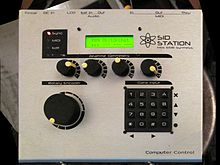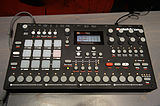Electron music machines
| Elektron Music Machines MAV AB
|
|
|---|---|
| legal form | Aktiebolag |
| founding | 1998 |
| Seat | Gothenburg , Sweden |
| management | Daniel Troberg, Daniel Hansson (†) |
| Branch | Electronic musical instruments |
| Website | www.elektron.se |
Elektron Music Machines , usually just called Elektron for short , is a Swedish manufacturer of electronic musical instruments , in particular synthesizers , drum computers , samplers and groove boxes .
history
In 1997, the students Daniel Troberg and Daniel Hansson at Chalmers University of Technology developed a simple synthesizer from a Commodore 64 chip. It contained three oscillators , three possible envelopes , four LFOs and an analog filter. The prototype was finally further developed and built into an aluminum housing and called the Sidstation . Ten copies were made at that time.
In 1998, Elektron was founded as a company. This was possible because the company received financial support from the university. The Sidstation was now being produced in larger numbers, but this soon came to an end as the Commodore chips were becoming increasingly difficult to obtain. The Sidstation was in great demand because of its innovative technology.
At the turn of the millennium, the company was working on the Machinedrum, a drum computer in which a 16-track sequencer is integrated. The Machinedrum SPS-1 MK.I came on the market in 2001.
In 2003 the mono machine appeared , which was a simulation of the Sidstation. Elektron became a private company, which ended funding from the university.
In 2007, Daniel Hansson, the founder and co-inventor of Elektron, died in a serious traffic accident. A memorial page was created for him on the Internet, on which it was possible to buy thirty songs for $ 5 until the beginning of 2011 . The proceeds were donated to the WWF . One of the last, new SIDstations was raffled off among all donors.
At the beginning of 2011, after a long announcement, the Octatrack DPS-1, an 8-track sampler with crossfader and up to 64 GB of memory, was presented. The Octatrack was the first major product that was developed without Daniel Hansson. As a promotion for the Octatrack, Elektron made a short film about a surreal world.
A branch was opened in Japan in 2012 and a new product under the slogan "Tradition & Future" was announced in autumn. After a video appeared in which a record was played with the sounds of the new device, Elektron released a short film on November 9, 2012 with the title "Analog Four - The Demon who wears me" (Analog Four - The Demon Who Wears Me ). The protagonist is "Hector", a fictional character who had explained the functions of the instruments in previous years. The film is set in an apocalyptic present and is used as a promotion for Analog Four.
equipment
Machinedrum
The Machinedrum is a drum computer with an integrated 16-track sequencer . The first version SPS-1 MK.I from 2001 was further developed in 2005 to MK.II and from 2010 with the extension UserWave and + Drive, currently offered as Machinedrum SPS-1UW + MK.II together with the MIDI interface TM-1. The latter can load samples from the PC into the Machinedrum at 10 times the speed of conventional midi samples and was developed in 2006. The background for the development of UserWave was the growing demand for new samples and connections. The design of the Machinedrum has remained the same except for a change in the color of the display bezel.
Monomachine
After the Sidstation and the Machinedrum, a real synthesizer was missing, which is why the company developed the Monomachine. In 2003 the mono machine SFX-6 appeared. It was a long console that consisted of the actual momomachine and a 37-key keyboard with joystick . This version was sold in a case similar to the Machinedrum. Monomachine and machinedrum should complement each other. In 2007, the unwieldy, long monomachine SFX-6 was replaced by the keyboard-less SFX-60 MK.I. This was also continuously developed and sold in 2010 as SFX-60 + MK.II (also equipped with + Drive).
Octatrack
The Octatrack DPS-1, released in 2011, is an 8-track sampler with crossfader and up to 64 GB of memory. The Octatrack completes the "Trinity" product range from Elektron. It is kept in black.
Analog Four
Analog Four is an analog, 4-track synthesizer that has been on the market since December 2012.
Analogous to Rytm
The Analog Rytm is an analog and 8-voice drum synthesizer that has been available since 2014 with the additional option of using samples .
Digitakt
Digitakt is a sequencer and sampler with up to 8 audio and 8 midi tracks. It was presented at the NAMM Show in January 2017.
Digitone and Digitone Keys
Digitone is a sequencer and FM synthesizer with up to 4 polyphonic audio and 4 midi tracks. Digitone Keys has a keyboard with 37 keys.
Model: Samples
Model: Samples is a sequencer and sampler with up to 6 tracks that can be used either for samples or midi data.
Model: Cycles
Model: Cycles is a six-track FM synthesis based groove box . Model: Cycles offers six tracks and six different "machines" for drums and synthesizer sounds. Elektron released the musical instrument on February 26, 2020.
membership
Elektron is a member of the German-Swedish Chamber of Commerce .
Web links
- Elektron.se: company website. Retrieved April 8, 2020 .
Individual evidence
- ↑ The inventor of Sidstation, Machinedrum and Monomachine is dead , De: Bug Musiktechnik, August 29, 2007.
- ↑ Introducing Model Cycles. Elektron.se, accessed on April 8, 2020 : "Elektron is delighted to introduce Model Cycles"
- ^ Elektron Music Machines MAV AB , German-Swedish Chamber of Commerce.







